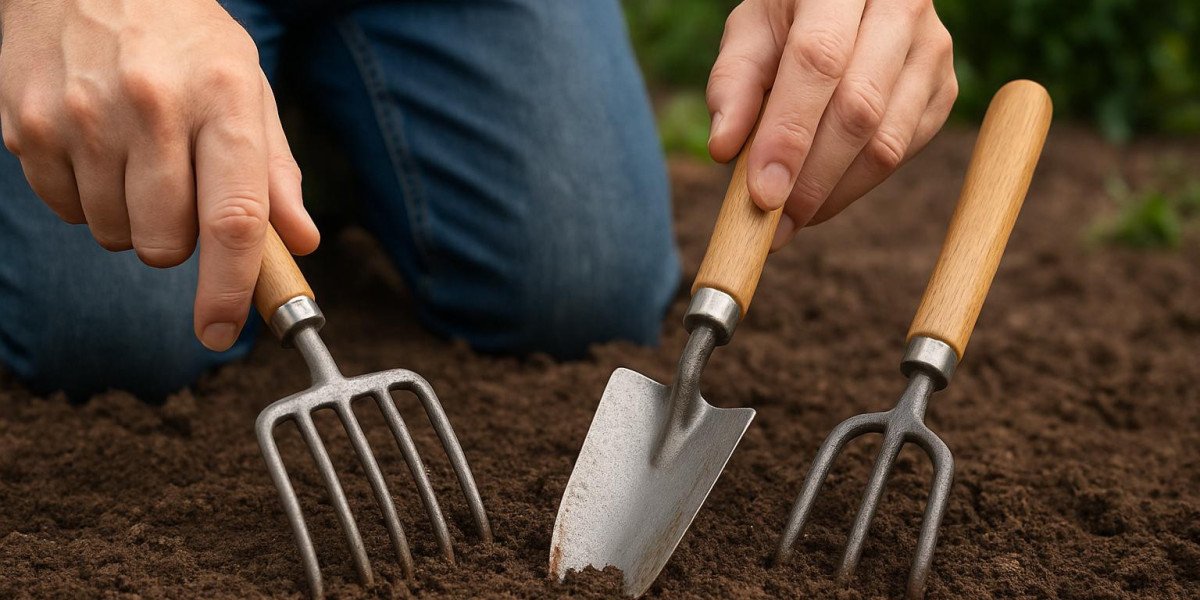Soil is the heartbeat of any thriving garden. But before it can support the life of flowers, herbs, vegetables, or shrubs, it needs to be prepared properly. The difference between a flourishing garden and a struggling one often lies beneath the surface. And it all starts with the right tools. While machinery plays its role in large-scale farming, in home gardens and small-scale plots, hand tools are the unsung heroes. These simple instruments, wielded with skill and patience, can transform compacted, lifeless dirt into fertile, well-structured soil primed for planting.
In addition to stirring the soil, hand instruments are essential for comprehending and nourishing it. They give gardeners the ability to engage directly with the soil through tactile feedback, control, and precision. This article examines the various hand tool types' contributions to each stage of soil preparation, their vital nature, and the reasons that using them for a period of time creates a solid foundation for success.
Soil Preparation: More Than Just Digging
Preparing the soil involves more than just starting construction. It include evaluating texture, enhancing structure, bringing pH levels into balance, and adding organic matter for enrichment. The conditions for root growth, water retention, nutrient availability, and long-term plant health are set by effective preparation.
These tasks are best completed by hand in smaller gardens because machines frequently lack the dexterity needed in small or delicate areas. Gardeners can "read" the soil with hand tools by detecting clumps, detecting worm activity, smelling indicators of a healthy microbiology, or feeling the soil's moisture content.
The Trowel: Precision Workhorse of the Garden
The trowel is one of the most common and useful hand tools. Digging tiny holes, adding compost, moving seedlings, and loosening compacted dirt close to plant bases are all made easy with this compact yet powerful tool. No mechanical tool can match the control that its sharp, scoop-like blade provides, particularly in confined spaces or container gardens.
When it comes to the initial stages of soil work, gardeners frequently overlook the importance of trowels. With their assistance, you may determine the depth and fertility of the soil, evaluate resistance during excavation, and incorporate organic amendments at exact depths.
It’s especially wise to Buy Garden Trowels that offer ergonomic handles and stainless steel blades, which stay durable even in clay-heavy soils. When choosing a trowel, weight and grip are critical—fatigue sets in quickly with poorly designed tools, and precision drops as a result.
Hoes and Hand Forks: Breaking and Turning with Efficiency
Hoes are great for removing weeds, breaking up topsoil, and making planting furrows. Before going deeper, they are essential for cleansing the surface. With the use of a hoe, you may effectively cut through loose loam or compacted ground, readying it for additional aeration.
However, for turning soil in raised plots or limited beds, hand forks are the most effective tool. Their powerful tines plough through the ground to loosen roots, break up clumps, and enhance texture. They are particularly helpful in the spring, when the soil is often compacted and lacks air after winter.
These instruments are extensions of your own touch, not merely blades and tines. Your method of working the soil will naturally alter when you encounter resistance or changes in texture.
Soil Aeration and Drainage: Hand Rakes and Cultivators
Soil needs to breathe in order to sustain life. The ideal conditions for rot and fungal growth are created by compacted, airless soil that stifles roots and retains water. The top layer is loosened, crusts are broken, and the surface is scratched by hand rakes and cultivators without unduly affecting deeper ecosystems.
Aeration increases oxygen availability and water intrusion. Claw cultivators and similar tools are perfect for mixing in compost, weaving through narrow beds, and guaranteeing uniform texture throughout. By using them frequently during the growth season, you can maintain soil health and avoid hardening.
According to statistics, well-aerated soil can boost crop yield by as much as 25% only by allowing roots to stretch out more easily and more effectively access nutrients.
The Role of Soil Knives and Dibbers
The dirt knife, also known as a hori hori, is a multifunctional instrument that combines the functions of a trowel and a knife. It is ideal for cutting through deep soil layers, slicing through roots, and even measuring planting depth because of its etched patterns and serrated edges and pointy ends.
Although they are not as well-known, dibbers are ancient implements used to puncture holes for bulbs or seeds. They provide accurate depth information and lessen soil disturbance. These are especially helpful in permaculture plots and no-dig gardens where it's crucial to preserve soil layers.
With these instruments, the tactile relationship between the gardener and the ground is most evident. You can gain a deeper grasp of the characteristics of your soil by feeling its resistance, modifying the planting depth, and navigating through root-dense places.
"The glory of gardening: hands in the dirt, head in the sun, heart with nature." – Alfred Austin
Soil Texture and the Finger Test
Hand tools help you do something machines can’t—feel. Determining soil texture (clay, silt, sand) is done most accurately by hand. Roll the soil between your fingers, squeeze it, crumble it—these actions tell you everything about its water retention, drainage, and what amendments are needed.
Soil texture affects:
How well nutrients are retained
The rate at which water drains or pools
After determining the type of soil you have, you can adjust your preparation methods accordingly. Using broad-tined forks and applying gritty compost to clay-heavy soils helps create space for water and air. Using a rake to work in organic matter improves the retention of moisture and nutrients in sandy soil.
The Importance of Ergonomic Tool Design
The way the tools you employ interact with your body is just as important to successful soil preparation as the instruments themselves. Over time, hand tools with poor design cause strain, inefficiency, and even injury. These days, many gardening tools feature lightweight carbon steel construction, wrist-aligned handles, and non-slip grips to make the activity easier and more comfortable for your joints.
These ergonomic advancements eventually lessen fatigue and enable longer, more fruitful gardening sessions. That makes a big difference whether working in the blazing heat or preparing vast beds.
Companion Tools: Buckets, Sieves, and Soil Testers
Hand tools often work in conjunction with other tools. For instance, you can remove pebbles or trash from fine topsoil using a sieve or soil screen. When moving compost, weeds, or stones that are discovered during excavation, buckets are necessary. Before planting, basic soil pH testers or moisture meters determine what amendments are required.
Adding two or three auxiliary tools to your primary hand tools will greatly increase your productivity and accuracy without making your toolset too complicated.
Integrating Organic Matter with Manual Tools
Repeatedly cultivated soil loses its nutrients and biological activity. It's crucial to reintroduce life into the soil using mulch and compost. For precise integration of organic material that ensures an even distribution without disturbing beneficial bacteria, hand forks and spades are ideal.
In contrast to over-tilling, which is increasingly being criticized for deteriorating soil structure, manual integration enables you to combine just the right amount. This gentle method promotes long-term fertility and retains carbon in the soil.
Comparing highly tilled areas to minimally altered soil using hand tools, a recent research by the Soil Science Society of America revealed a 15% improvement in moisture retention.
FAQs
Why is soil preparation important before planting?
Proper soil preparation ensures optimal conditions for seed germination, root development, and water absorption. It also reduces weeds and pest issues.
Which hand tool is best for beginners?
A garden trowel is the best starting tool for beginners. It’s versatile, easy to use, and perfect for small-scale digging, planting, and mixing.
How deep should I work the soil?
Most vegetables and flowers require the top 6 to 12 inches of soil to be loose and enriched. The depth can vary depending on plant type and soil condition.
Are hand tools better than power tools for soil work?
For small to medium gardens, hand tools offer more control and cause less disruption to soil ecosystems than power tools. They also allow more accurate work around roots and seedlings.
How often should I amend the soil?
At least once a year, preferably in early spring or fall. However, adding compost or mulch seasonally can help maintain soil vitality throughout the year.
Where Tools Meet Touch: The Real Power of Manual Soil Prep
Hand tools keep gardening grounded, both physically and figuratively, in an era of automation and technology. They create a strong bond with the land, slow down the process, and promote observation. Although it may appear unimportant, soil preparation is the cornerstone of all good plant growth.
The sound of a rake disintegrating compost, the soft turn of a cultivator loosening soil, or the rhythm of slicing into dirt with a spade, these are not only chores; they are rituals. They train your eye for change and opportunity and help you better grasp the demands of your garden.
Perhaps the greatest role hand tools play isn’t just in preparing soil, but in preparing the gardener. They sharpen your patience, refine your technique, and reward your effort with visible results.
Must Read: Soil Preparation for Carrot Farming: Setting the Foundation for Healthy Roots






